
Humans and Robots: What Awaits Us? - Photo credit: medium.com, edition of Amber255 via bitLanders
One hundred years ago, many political revolutions began; today, the technical revolutions are coming. One has matured in robotics. There, success follows one after another. Robots have long helped us in production; they are capable of leading our household, and listening to our wishes. We are becoming more attached to them and even respect them.
Probably, soon, we will not be able to distinguish some robots from humans either by their actions, or by their designs, or by their appearance. The spirit of the time is such that the need for the emergence of social robots is obvious. It’s not for nothing that the sovereign of current thoughts, Facebook founder Mark Zuckerberg somehow jokingly said that he intended to create an electronic friend for himself.
Overcoming the limitations stemming from our physical bodies by accepting new technologies – this is human evolution. - Hiroshi Ishiguro
Credit: gq-magazine
Recently, people, indeed, increasingly have to deal with robots that look like a human being. Of course, most of the robots we use are far from this image, but still, the progress in the development of anthropomorphic robots is very noticeable. In the laboratory, you can measure your head in just 20 minutes, and then based on this data, make your copy. You can make sure that robot followed your glance, you can give his face a meaningful expression, give him mimics. By recording your conversation on a mobile phone, you can then teach the robot to speak the same as you. If any of your friends will talk to this robot on a video phone, he will be sure that he is talking to you.
I can imagine that a generation of children will grow up who will get used to playing with robots, and mentally it will be harder and harder for them to distinguish humans from robots. Robots and humans are more and more connected.
Female Android Geminoid F first singing performance - Video credit: youtube
Robots Evolution
Initially, robots were our slaves. It's no secret that the great Czech writer Karel Capek invented the word robot. Much less is known that the Czech word "robota" means enslaved labor. However, the robots differ from slaves in that they are ready to rebel against the enslavers. Meantime, even those workhorses are gradually becoming humanized. It's about the factory robots - all these mechanical arms, powerful hinged pieces of iron. Most are still carefully fenced in order not to harm people.
But there are also the first models, ready to cooperate with the person. They stand at the conveyor next to the workers, react to their gestures, and instantly freeze (turn off) if something dangerous is close to them.
In the production shops of the Tesla company engaged in the production of electric vehicles, you will not meet welders, mechanics, workers on the conveyor at all. They were replaced by mechanical hands of robots. Made as if without human intervention, the machines will do without him and on the road. After all, we are talking about self-managed cars.
More and more robots appear in everyday life. There are simple explanations for this. The capabilities of artificial intelligence have unusually expanded. The cost of robots is rapidly decreasing. For example, several years ago, the most important motion sensors cost $ 5,000, now less than a hundred. Today, computers are inseparable from us, so the same will be with robots in the near future.
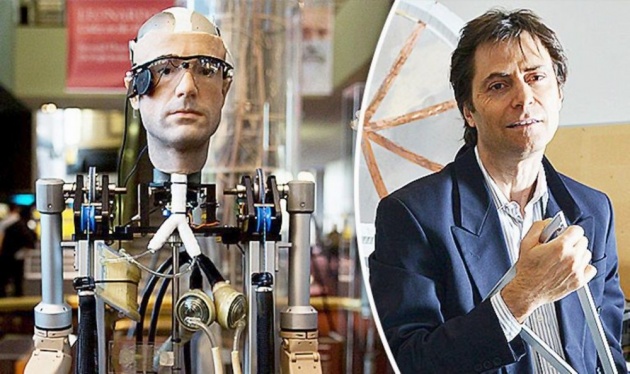
Humans and robots - Photo credit: twitter
Differences Between Humans And Robots
What unique will remain to the human if robots start even think like humans?
The strength has long been on the side of robots. The mind, the intellect, flows to their side from the human's side all the time continuously.
The whole treasury of knowledge collected by many generations of people is now at the complete disposal of robots, and they use these riches better than us, whose poor brain holds only a fraction of knowledge, and not all at once.
We can only feel it and reflex. We have no rivals here. Robots are senseless. Robots only juggle gigabytes of information, finding one necessary word in one second in a hundred thousand volumes. They read all the texts of the world, enclosed in electronic format. They translate all the languages of humanity - from Abkhaz to Japanese. Even their visual memory - unlike ours - is close to ideal: they easily recognize people's faces, even if they are constantly showing different facial expressions.
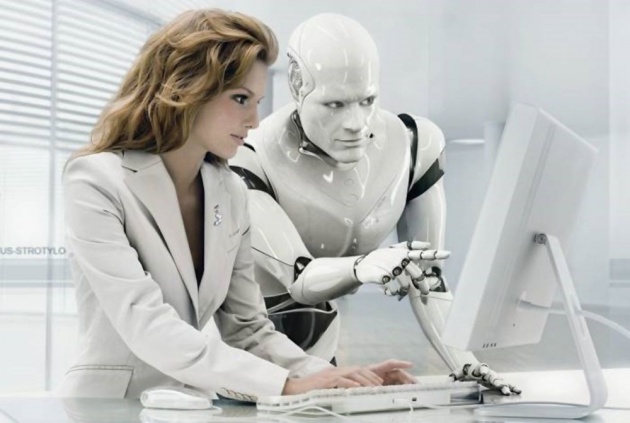
Future of Robotics - Photo credit: medium
Instead of veins and bones, these skating shadows consist of a steel skeleton, an electric motor, numerous gears, and wiring, but you cannot see anything from the outside. Strands of hair and eyelashes, eyes and lips are completely natural. The skin of special silicone (flesh rubber) has, like human skin, the smallest pores. It perfectly imitates any folds of our skin.
The inventor of this silicone, American David Hanson, himself creates android robots. The most famous is his robot with the head of Einstein (however, it is mounted on the standard torso of the robot, which only schematically conveys the human figure). But another copy of the celebrity - the robot Mark 1 very accurately conveys her star prototype, actress Scarlett Johansson, and even speaks in her voice.
Time ago, somewhere on the net, I saw the graphs with the intellect level of robots. It was a straight line, persistently striving upwards from a decade to a decade. The line, corresponding to the human intellect, drags monotonously parallel to the time axis sometimes even coming close to it. This leads to sad reflections, above all, that, sooner or later, the powerful collective mind of the robots cannot be kept under our control. What do we oppose to them?
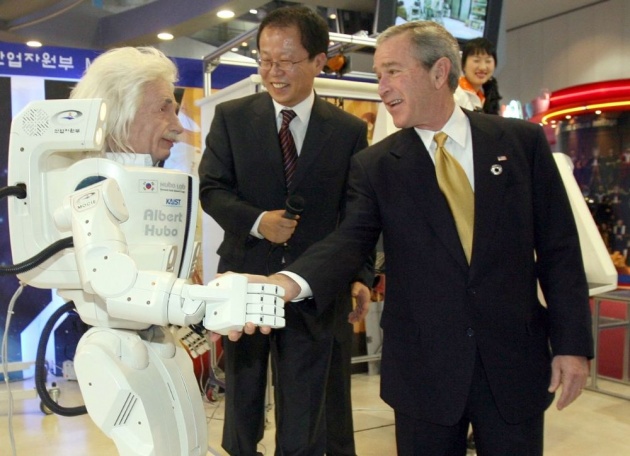
President George W. Bush shaking hands with the robot - Einstein - Photo credit: picswe
Among futurologists, there has long been dissatisfaction with the coming dominance of robots - these calculating machines, which will first take away our jobs and someday they will take us from the world. We will become a problem for them, which they will solve, like Terminator, intelligent machines from the Matrix or HAL-9000 robot solved it - decided to shoot sleeping astronauts. Should we believe it?
Thinking just about the tendency, physicist Stephen Hawking and business person, inspirer of large technical projects, owner of Tesla, Elon Musk, are already warning us about the coming domination of smart machines, about the unbearable gravity of being under the superior of robots.
It all began with hope. With the Second World War's end, people had distorted themselves in their dreams and began to build a new future - ideal technocracy with the support of computers and robots.
One can only be confused to guess what a terrible power the state will have, this invisible mega machine if it puts at its service robots instead of humans. But whose state will it be? For whom will it exist - for humans or robots?
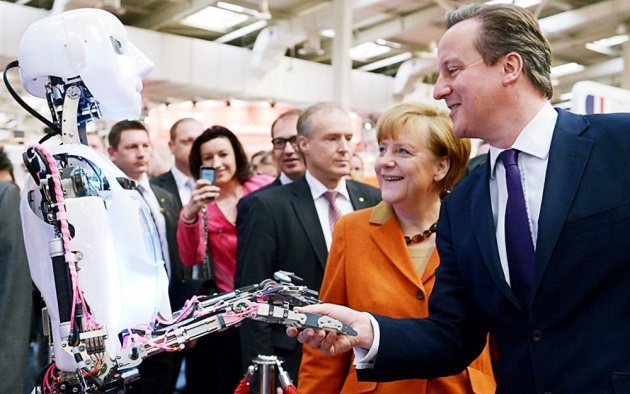
Politics and robots - Photo credit: picswe
Professor Hiroshi Ishiguro
Today, the capital of the robotics world is the millionaire city of Osaka, which lies on the Pacific coast, not far from the ancient imperial capital of Japan, Kyoto. In the past decade, Professor Hiroshi Ishiguro of Osaka University has become a real star in the West. Perhaps, he is the most famous expert in the world on androids robots, that is, robots who are similar to humans as twins are to each other. He is a supporter of the beautiful new world, where robots will live next to people.
The creator of the robot-people is devilishly attractive. He is always dressed in black: a black sweater, black pants, black shoes. The windows in his office are traditionally curtained; On the walls hang portraits of the creator of the inanimate people and his creations.
The University headed by Hiroshi Ishiguro gives birth to exact copies of people. Their speeches are meaningful; their facial expressions are expressive, like those of actors shining on stage. Their appearance is amazing. Soft, warm skin, elastic to the touch; long silky hair, falling on a blouse or pullover; blush on the cheeks; narrow strips of lipstick on the lips; perfect eyebrows.
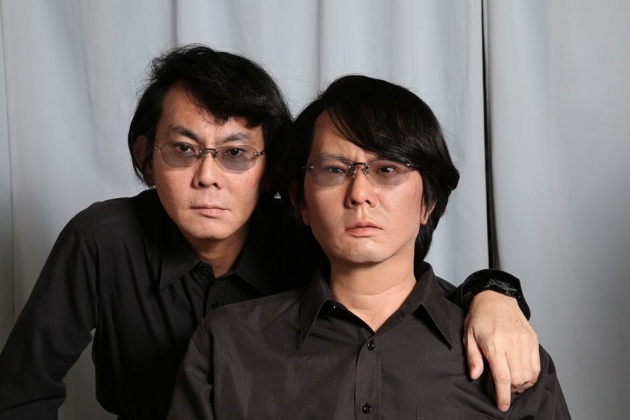
Robots of Hiroshi Ishiguro: Geminoid- a copy of H. Ishiguro- Photo credit: twitter
Android robots themselves are easier than other machines to live in a world created for people: climb the stairs, press the call buttons, open the doors. Hiroshi Ishiguro even came up with a new name for the robots he creates: Geminoids (from Latin Geminus -twin ). Geminoids are replicas of real people. And their habits are added too.
Before starting work, Hiroshi Ishiguro employees (there are only three dozen) not only measure the parts of the body of the prototypes but also study their facial expressions, way of moving, and gesticulating. Taught by the subtlest nuances of human behavior, these robots now look like their three-dimensional shadows, which have forgotten their place and living a new life.
According to Hiroshi Ishiguro, the future belongs to robots, androids, human robots. We communicate with people from the first days of life; we command them with gestures, words, even grimaces. We are used to it. It will be easier for humans to control robots that look like humans and not a strange construction with many toggle switches.
Hiroshi Ishiguro on Future of Robotics, Robotic Governance and the Impact on Society - Video credit: youtube
Ishiguro's Creations
Back in 2006, Hiroshi Ishiguro created a self-portrait that is always with him - a robot indistinguishable from himself. His ageless artificial twin, Geminoid HI appeared next to the scientist. His daughter came to play with this living toy. Her father, preparing for the conference in Zurich, asked which of the two Hiroshi Ishiguro colleagues want to listen to. So, his copy flew to Switzerland accompanied by an assistant.
However, the most amazing fate has the Geminoid F, the brainchild of Hiroshi Ishiguro. Perhaps, the Hollywood career is waiting for him. Indeed, in 2015, this beautiful robot played a major role in Koji Fukada’s film Sayonara, shown at the festival in Tokyo.
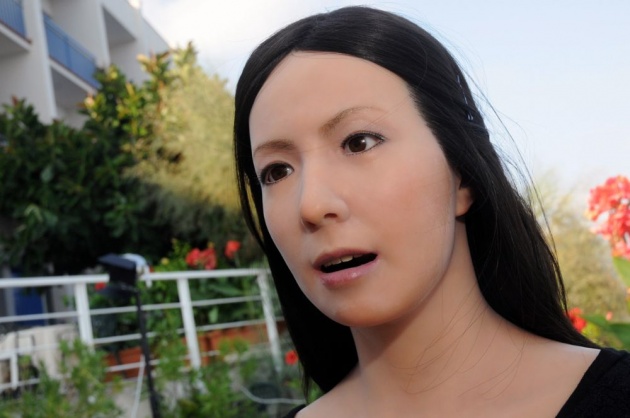
Geminoid F with artificial intelligence - Photo credit: oldvorchun.blogspot
Another human-like robot (Geminoid DK), created by Hiroshi Ishiguro, interacts with smart people far from Tokyo. He looks like one of the teachers at Aalborg University, Henrik Scharfe. It happens that in the audience instead of the teacher appears his clone. According to the Danish professor, some students notice only at the break that the robot communicated with them the whole lecture.
Hiroshi Ishiguro intends to create a whole army of remote-controlled robots that will do tasks beyond the capacity of humans, will take action where people do not want to appear. In the spring of 2015, a five-year project started, designed to teach man’s artificial twins to autonomous behavior. Ishiguro is sure that over time, they will act independently, consistent with their needs and goals set for them. They will themselves get in touch with people, clarify the tasks or reporting on what they have done; they will begin to charge the battery.
Hiroshi Ishiguro believes that robots will become not only human's assistants but also real friends of man. He is even convinced that someday people will fall in love with them.
Chat with me on QUERLO CHAT about human-like robots:
Japanese Love Robots
It is not by chance that a Japanese researcher speaks about the love of robots. In Shinto, the national religion of the Japanese (and the state religion of their country until 1945), everything has the soul as humans, no matter what it is: stone or metal. In this belief lie the special attitude of the Japanese to the robots and their apparent success in the art of creating robots.
Western civilization has created a myth about frightening soulless machines that will inevitably rebel against humans. Android robots, these humanized machines have long become the characters of the darkest fantasy works.
The whole world knows that the Japanese love robots. Since the end of the 1990s, Japanese families began to start an electronic dog Aibo, produced by Sony. This robot dog has become for many a loyal friend, a member of the family. Another robot, Paro seal, comforts the patients suffering from Alzheimer's disease.

Robots of Hiroshi Ishiguro: Geminoid DK - Photo credit: youtube
We can love robots just like we love pets. Japanese children already accustom to robots since their childhood. Over time, these mechanical people will play an increasingly important role in society. After all, Japanese society is aging rapidly. In 2025, according to scientists, almost two and a half million Japanese will engage in caring for the elderly (one and a half times more than in 1990).
In Japan, a country that for centuries was closed to foreigners, a country that even now does not like to welcome them, they found a different solution to the problem. To care for the elderly will attract robots with almost a human soul. Experiments show that nursing home residents are truly happy in dealing with such helpers and friends.
In recent years, the idea of transhumanism has become popular among futurologists - the gradual transformation of people into robots with the help of special implants and gadgets. Hiroshi Ishiguro believes that only technology makes any person a true human being.
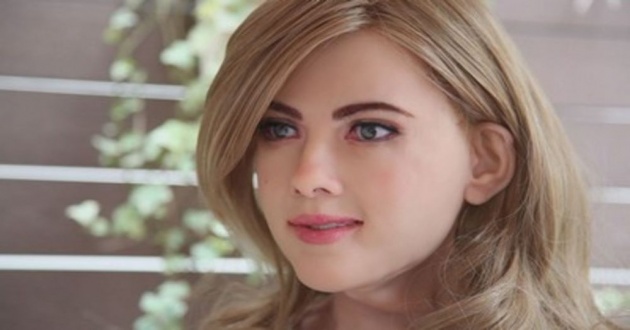
Robot Mark 1 created as a copy of actress Scarlett Johansson - Photo credit: youtube
On A Final Note
Android robots are bound to be more than service robots. They will certainly be social beings, part of human society. Robots can become for us something more than servants, become our friends. Should we not, over time, give robots the same rights as humans? If we give robots rights, then, probably, they, sooner or later, will receive the right to elect and be elected to the highest authorities.
So, maybe someday the robot will become the president of one of the leading countries of the world? Why not? Looking at the leaders of some states, be it the DPRK or Zimbabwe, I believe that robots can control people better than people themselves. OK, let it be a joke because I am against any rights given to robots. At least, for now.
And who knows where evolution will turn in the future? Perhaps sometime in robots, the consciousness will arise. The problem is that we still do not know how It originates in the heads of people. Perhaps, we will not understand this even when we throw a spark of consciousness into the computer brain of a robot.
After all, the inventors, creating the first aircraft, did not fully understand the aerodynamics laws. Other scientists advise closer look at newborn children. Those hit the world, completely unfamiliar to them. Children receive from the outside world a lot of sensual information. Gradually, they have an image of this world and an image of themselves. They are born self-consciousness. Maybe the same will happen with robots?
And finally, before we say goodbye to our today's heroes, we will again recall the movie Sayonara, where a robot woman named Geminoid F played a role. The topic has become more relevant than ever). The main character, Leona, is a robot, a friend of a woman doomed to death, infected by radiation. Leona does not understand what death is.

Geminoid F in a movie Sayonara - Photo credit: imdb
People are mortal, but robots, in principle, no. This is what scares us in robots. Robots do not age; theoretically, they can live forever. They will endure us, wait out until we destroy ourselves, and continue the evolution of life on Earth, revealing its higher level. More conscious, wise, universal than we are, weak, short-lived creatures, all the time attacking each other and thus shortening our life span.
If we want to build robots to interact with, why not make them look more like us? - Hiroshi Ishiguro
Credit: gq-magazine
**********************************************************************************************
Thank you for stopping by and reading my blog
2019, All Rights Reserved.
You are very welcome to join Bitlanders and share your valuable knowledge and opinion.
***********************************************************************************************



